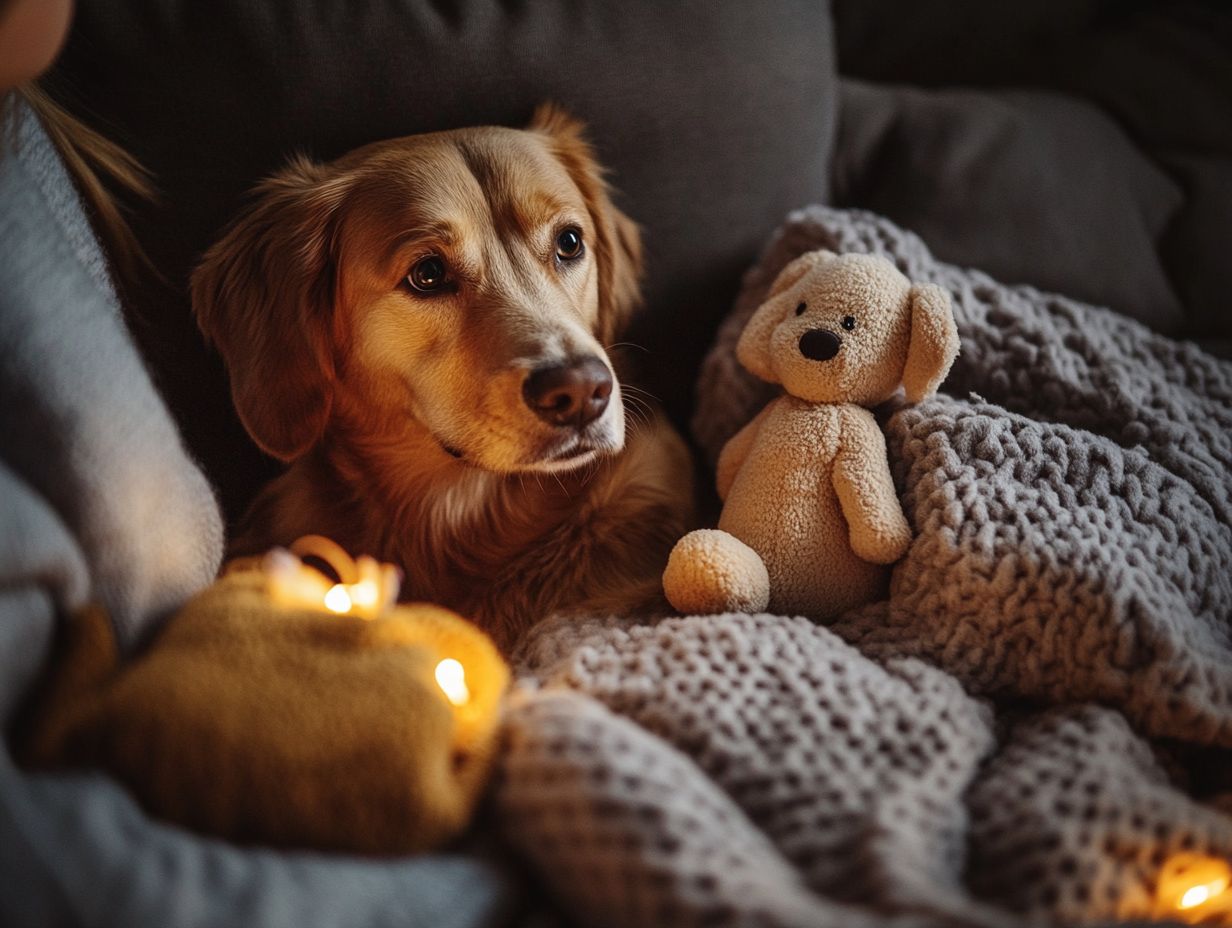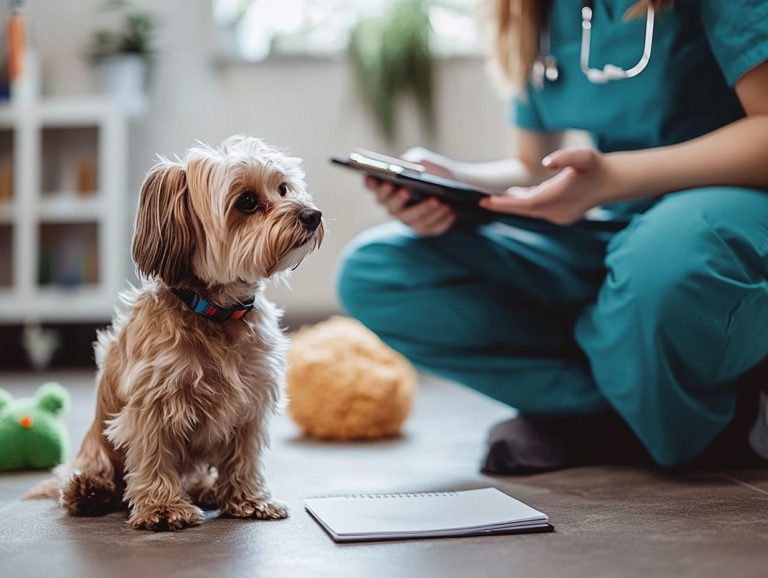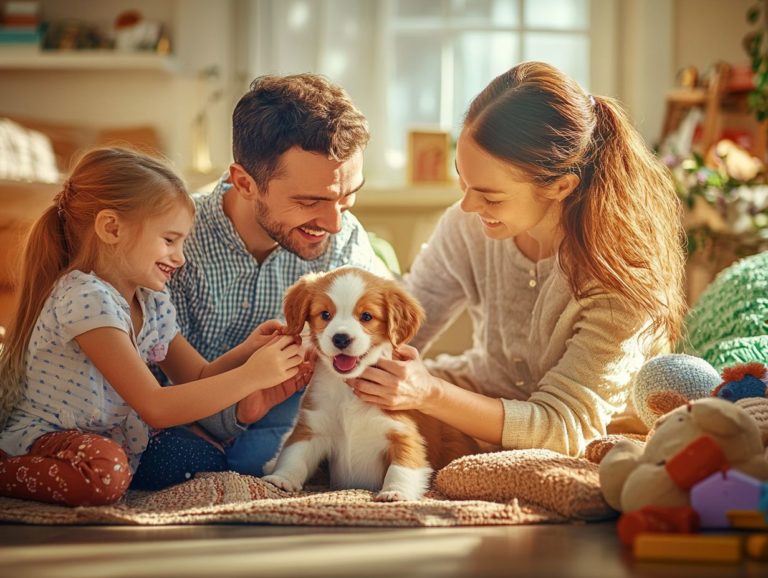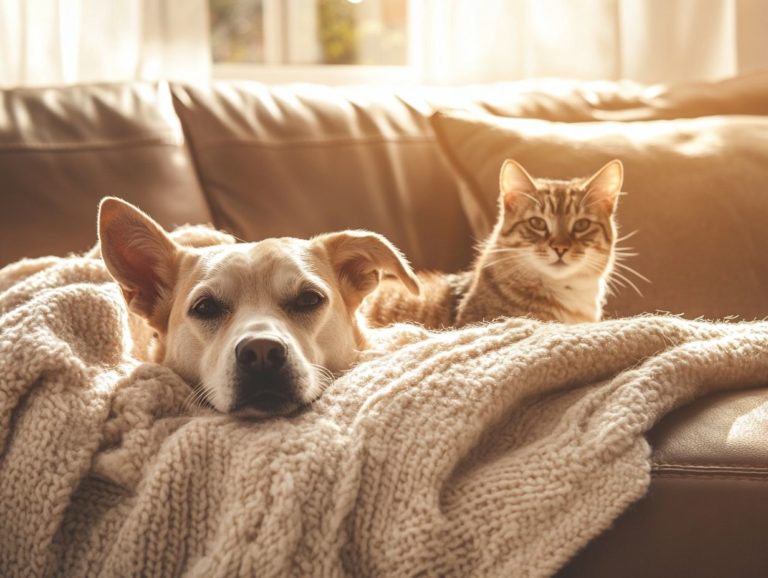What Are the Key Factors in Understanding Pet Anxiety?
Pet anxiety is a common concern that affects many beloved companions and significantly impacts their well-being.
As a pet owner, you need to spot what triggers your pet s anxiety, whether it’s environmental factors or separation issues.
This article covers signs that show your pet might be stressed, alongside effective management strategies, training techniques, and preventive measures to create a calm environment.
Discover how to help your pet feel more secure and at ease.
Contents
- Key Takeaways:
- What Every Pet Owner Should Know About Anxiety
- Causes of Pet Anxiety
- Signs and Symptoms of Pet Anxiety
- Managing Pet Anxiety
- Preventing Pet Anxiety and Behavioral Issues
- Frequently Asked Questions
- What are the key factors in understanding pet anxiety?
- How does a pet’s breed and genetics affect their anxiety?
- Can a pet’s previous experiences contribute to their anxiety?
- What role does the current environment play in a pet’s anxiety?
- How can a pet owner’s behavior and relationship with their pet affect anxiety?
- Are there any other factors that can contribute to pet anxiety?
Key Takeaways:

- Pet anxiety is a common condition where pets experience excessive fear and stress, affecting their overall well-being and behavior.
- Environmental triggers and separation anxiety are key factors contributing to pet anxiety. Identifying and addressing them is essential for management and prevention.
- Training and behavior modification techniques, along with calming products (like special collars or sprays) and supplements, can effectively manage pet anxiety and foster a calmer atmosphere.
What Every Pet Owner Should Know About Anxiety
Understanding pet anxiety is crucial, as it profoundly affects the emotional well-being of dogs and can lead to a range of behavioral issues if left unchecked. Seeking guidance from a great pet anxiety specialist can be beneficial in addressing these concerns.
Is your dog displaying signs of anxiety? Common forms include:
- Separation anxiety
- Fear-related anxiety triggered by loud noises like thunderstorms or fireworks
- Aging anxiety associated with thinking problems
By recognizing these anxiety disorders, you can seek appropriate treatment options and professional help, enhancing your pet’s quality of life.
What is Pet Anxiety?
Pet anxiety, particularly in dogs, involves a range of emotional responses leading to undesirable behaviors such as excessive barking, destructive habits, and even aggression.
It encompasses various anxiety disorders, notably separation anxiety, which occurs when a dog is left alone, and fear-related anxiety triggered by external stimuli.
Situational anxiety can arise from environmental changes like moving to a new home or exposure to loud noises. You may notice symptoms in your dog, such as trembling, pacing, or hiding. For example, if your dog begins drooling excessively or refuses to eat during a thunderstorm, they are likely experiencing fear-related anxiety.
If your pet exhibits destructive behaviors like chewing furniture when left alone, it may indicate separation anxiety. Recognizing these behavioral shifts is vital for effectively addressing your pet s needs.
Causes of Pet Anxiety
The causes of pet anxiety are complex and can arise from various factors, both external and internal. Environmental triggers like loud noises from thunderstorms or fireworks can be particularly distressing, making it important to explore resources for learning about pet anxiety.
Disruptions in routine can also raise a dog s anxiety levels. Understanding these underlying anxiety causes is crucial for implementing effective anxiety management strategies that can significantly improve your pet s well-being.
Environmental Triggers
Environmental triggers play a big role in pet anxiety. Loud noises from thunderstorms and unfamiliar sights can create stress for your dog.
For instance, sounds like fireworks or construction can turn a calm dog into a bundle of nerves. They might hide or bark excessively.
Changes in your home, like moving or getting a new family member, can also increase their stress levels.
Fortunately, there are effective strategies to help. Creating a safe space with familiar scents and fun toys can work wonders.
Training methods, like desensitization and counter-conditioning, can help your dog adjust to stressors and become more relaxed.
Separation Anxiety

Separation anxiety is a common issue in dogs. It happens when they feel distress when you’re not around.
Symptoms include barking, destructive behavior, and attempts to escape. This can be alarming and might require professional help.
Various factors can cause this condition, like household changes or traumatic experiences. Some dogs may even show signs of anxiety before you leave, like pacing or drooling.
Creating a safe space for your dog can help them feel secure. A consistent daily routine will provide the stability they need.
In tough cases, contacting a veterinarian or certified animal behaviorist can be beneficial. They can offer tailored treatment options, including medication or specialized training.
Signs and Symptoms of Pet Anxiety
Recognizing the signs of pet anxiety is crucial for you as a pet owner. Early intervention can help reduce behavioral changes.
Watch for signs like excessive barking, destructive behavior, and changes in eating habits. These often indicate distress and need your attention.
Behavioral Changes
Dogs with anxiety may show various unwanted behaviors. This can include aggression, incessant barking, withdrawal, or avoiding social interactions.
Understanding these changes is key to managing anxiety and encouraging positive behavior. These issues can lower your dog’s quality of life and create stress for you.
Look for signs like pacing or lip licking; these often arise when anxiety sets in. Implementing positive reinforcement training can help build trust and security.
Early socialization is also important. It helps your dog adapt to new situations and reduces anxiety over time.
Working with a qualified dog trainer can provide personalized support and tools to guide your dog toward confidence and tranquility.
Managing Pet Anxiety
Managing your pet s anxiety takes a well-rounded approach. Combining different treatment options, effective training, and calming products is essential.
This strategy can lead to a more peaceful home for both you and your furry friend, greatly improving their emotional well-being.
Training and Behavior Modification
Training and behavior modification techniques are essential for effectively addressing and managing your dog’s anxiety. Using methods like positive reinforcement encourages the behaviors you want to see. Collaborating with experienced dog trainers allows you to implement strategies tailored specifically to your dog s unique anxiety triggers.
This approach not only reduces stress but also strengthens the bond between you and your furry friend. Positive reinforcement techniques think treats, praise, or playtime are particularly effective in fear-inducing situations. Gradually exposing your dog to anxiety-provoking stimuli while rewarding calm behavior can reshape their reactions over time.
Establishing a consistent routine can enhance this process, as predictability in daily activities fosters a sense of security. Working with professional trainers helps ensure that the techniques you employ are effective and appropriate, maximizing your chances of alleviating anxiety and nurturing a happy, balanced furry friend.
Medications and Supplements

When your training strategies don’t quite hit the mark, consider medications and supplements to manage your pet’s anxiety effectively. Options like anxiety medication, calming products, and natural therapies such as CBD oil can provide substantial relief, especially when used in consultation with your veterinarian.
Veterinary professionals are eager to explore various treatments. Medications like selective serotonin reuptake inhibitors (SSRIs) including fluoxetine and tricyclic antidepressants such as clomipramine are essential for alleviating symptoms in dogs diagnosed with anxiety disorders. These medications work to normalize brain chemistry, fostering a sense of calm. When paired with prescribed medications, calming products like anxiety wraps and pheromone diffusers can further enhance relaxation.
Natural therapies like herbal supplements and aromatherapy can be great additions to your pet’s care. It s crucial to consult with your veterinarian before implementing any new treatment plans, ensuring that the approach is safe and effective for your beloved companion.
Preventing Pet Anxiety and Behavioral Issues
Preventing pet anxiety is a proactive endeavor that requires you to cultivate a calm and stable environment for your dog. By implementing effective strategies for anxiety prevention such as ensuring regular exercise, providing environmental enrichment, and maintaining a consistent routine you can significantly diminish the chances of your pet developing anxiety disorders.
Tips for Creating a Calm Environment
Creating a calm environment for your dog is essential for preventing anxiety. It begins with establishing a safe space where they feel secure. Incorporate environmental enrichment, such as engaging toys and mental stimulation, which significantly contribute to your dog’s overall health and stress relief.
Enhance this environment by designating a quiet area with comfortable bedding, removed from daily life s hustle and bustle. Include toys that challenge your dog s mind to keep them occupied and reduce boredom-related anxiety. Regular playtime not only strengthens the bond between you and your pet but also promotes their physical health.
Simple activities like puzzle games or nose work can captivate their attention and provide the mental stimulation they crave. Together, these strategies foster a sense of security and encourage emotional well-being, leading to a happier, healthier furry friend while helping to mitigate anxiety symptoms.
Frequently Asked Questions
What are the key factors in understanding pet anxiety?
The key factors in understanding pet anxiety include the animal’s breed and genetic predisposition, previous experiences and socialization techniques, current environment and living conditions, and the pet owner’s behavior and relationship with their pet. It’s also important to debunk common misconceptions; for more information, check out what are the myths about pet anxiety.
How does a pet’s breed and genetics affect their anxiety?

Some animal breeds are more likely to experience anxiety because of their genetics. For example, certain dog breeds may feel anxious when left alone, while others react strongly to loud noises or changes in their routine.
Can a pet’s previous experiences contribute to their anxiety?
Absolutely! A pet’s past experiences, especially trauma or poor socialization, can greatly affect their anxiety levels. If a pet has faced mistreatment, they may become fearful in certain situations.
What role does the current environment play in a pet’s anxiety?
A pet’s living environment significantly impacts their anxiety. Noises, stimulation levels, and interactions with other animals can all increase stress.
How can a pet owner’s behavior and relationship with their pet affect anxiety?
A strong relationship with a pet can help reduce anxiety. If a pet owner is inconsistent or nervous, their pet may become anxious as well.
Are there any other factors that can contribute to pet anxiety?
Yes, other factors like changes in routine, lack of exercise, and medical conditions can also affect anxiety levels. Pet owners need to recognize and address these issues quickly!






